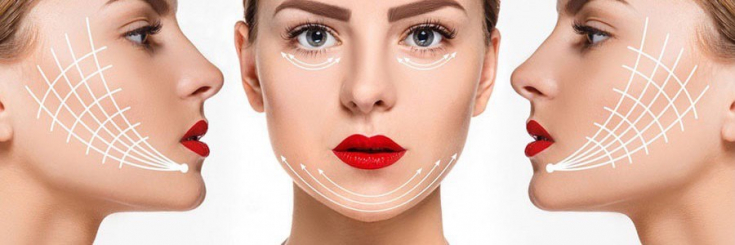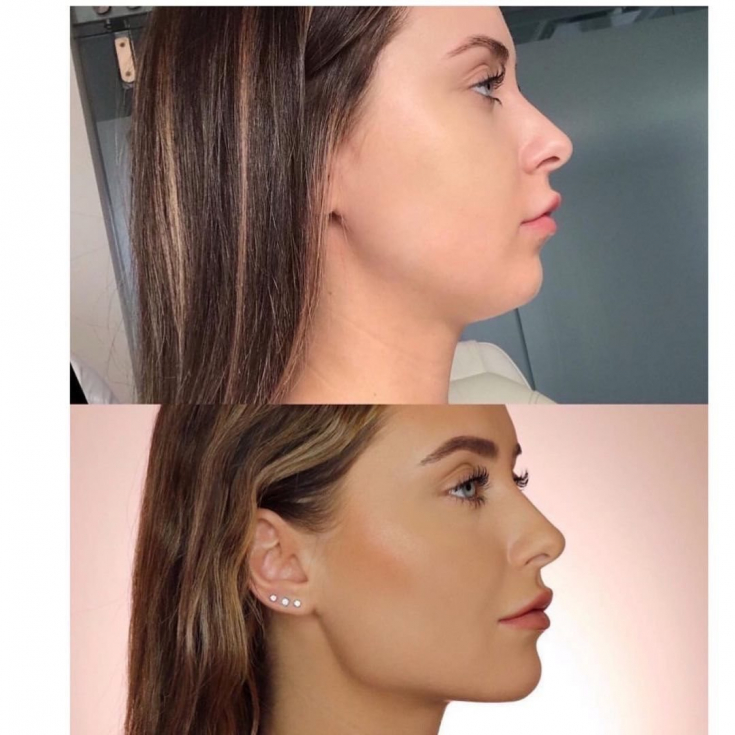Patients often experience loss of a pronounced jawline, which is usually associated with age-related changes. The loss of a clear facial profile and the volume of the lower third occurs due to bone resorption and changes in the subcutaneous fat. In aesthetic medicine, they are used as surgical methods for correcting the lower third, for example, implants, bone grafting, but non-surgical methods are also widely used, namely the introduction of dense fillers in this area. The article on ester-portal.com describes non-surgical correction methods to harmonize the patient profile .
- Required conditions for successful correction of the lower third of the face
- The working method of harmonizing the lower third of the face
- Difficulties and potential complications
- Output
Required conditions for successful correction of the lower third of the face
Precise placement of selected filler at the angle of the mandible, in the chin and jaw area can recreate an aesthetically youthful structured jawline.
Before performing procedures on the lower third, it is recommended to first correct the upper and middle thirds of the face to ensure reliable support of the jaw line.
The temporal region and cheekbones are the first thing to pay attention to.
It is important to recreate the angular contours and clarity, as in patients with loss of volume in the lower third of the face, the line passing from & nbsp; the jaw to the neck is low.
Read also: Correction of the middle third of the face, what to choose?
In contrast to the midface, where the curves and transitions are gentle, the jawline should show relatively sharp and angular transitions towards the neck.
The profile of the face can be conditionally divided into three main units: the angle of the lower jaw, chin and jawline.
The method of harmonizing the lower third of the face
-
Mandibular angle
The angle of the mandible is often an under-treated area. It is located on the side of the face and is therefore less likely to be seen in self-portrait and self-reflection photographs of the patient.
The angle of the mandible can be defined as the angle formed by the junction at the gonion of the posterior border of the ramus and the inferior border of the body of the mandible.

Radiological studies show that women have an average mandibular angle of 125°, which is statistically significantly higher than that of men. However, the gonial angle also varies significantly between women of different age groups, so the goal should be to identify and enhance the natural angle of the patient's mandible.
Mandibular angle:
- Identify any loss of preauricular volume and fill it in.
- Palpate and mark the angle of the mandible.
- Using a needle, create an entry point that is slightly medial to the angle of the mandible (approximately 0.5 cm).
- Highlight the proposed lower border of the ramus and posterior part of the mandible.
- Using a cannula, aspirate before injection.
- Perform slow retrograde thread-like movements in the area of the angle of the jaw, (0.1 ml per thread), for a total of 0.5 ml - 1 ml per side.
- Gently palpation of the mandibular ramus with the edges of two fingers helps to create a perfect angular contour and profile of the face.
Read also: Key zone of aesthetic cosmetology.
Dangers:
The facial nerve and parotid gland are at risk during back volumizing branches of the lower jaw. These structures are located in the musculoaponeurotic system (SMAS). They can be avoided by introducing into the subcutaneous plane. By injecting the lower boundary of the branch, also pay attention to the facial artery, which runs along the anterior border of the masticatory muscle.
Chin Harmonization:
When delineating the chin, start by assessing the length of the chin, the anterior projection, and the depth of the precheekal sulcus. The rule of thirds can be applied to determine if a chin needs lengthening. However, as a rule, aging causes resorption of the mandible and hyperactivity of m. mentalis. All these factors contribute to a shortened chin and a shortening of the lower third of the face.
Technique:
- Evaluate the deformity of the contour in the prebuccal sulcus, mental fold and m. mentalis.
- Palpation and marking of the chin pogonion.
- Improve the projection and length of the chin with deep dermal fillers using a sharp needle.
- For cannula work, select an entry point that provides access to the sulcus.
- Perform aspiration test.
- Slow retrograde threads, with filler fluffing (0.1 ml per thread) up to 0.5-1 ml per side.
- Gentle palpation helps to smooth the treated area.
Dangers:
The inferior alveolar artery and nerve emerge from the mental foramen, which is usually located between the first and second premolars, this area must be protected during direct injections.
Read also: Relaxing the masticatory muscles to harmonize the middle third.
Mandibular angle:
When treating the angle of the mandible, followed by the chin, the soft tissues surrounding the jaw area (supralateral and inframedial) are slightly taut. Therefore, less product is needed when focusing on the jaw. Usually three perpendicular filler threads can adequately form the lower edge of the jaw.
Technique:
- Determine the boundaries of the lower jaw.
- Mark and palpate the chin pogonion and mandibular angle.
- Highlight the lines that connect the angle of the mandible to the pogonion of the chin, representing the lower edge of the branch.
4. Conducting aspiration test.
- Injection of slow retrograde filler threads, from 0.1 ml per thread to 0.5 per side.
- Gentle palpation of the mandibular ramus between the edges of the two fingers helps to better distribute the filler.
Dangers:
Be careful not to add volume to the jaw as this will detract from the appearance. The mental artery, nerve and facial artery should also be taken into account when correcting the chin.
Difficulties and potential complications
Jaw sculpting is a complex area of correction. The severity and decline of the upper two-thirds affect the lower third, often requiring pretreatment. This is a large area of treatment and requires a sufficient volume of dermal filler for a satisfactory result.
Correction of the lower third of the face implies higher financial costs on the part of patients, who in turn require a higher aesthetic result.
The risk of intravascular injections can be minimized by remaining in the superficial (subcutaneous) plane or in the deep (periosteal) plane. Similarly, pre-injection aspiration testing may minimize the risk of intravascular injection.
Output
A straight, pronounced jawline is an area of correction that patients often request. At the same time, this is a complex area that experienced injectable users with appropriate training should be able to access. Strict adherence to the rules and preparation ensures maximum results and minimizes possible complications.
Source: Blog IMCAS education.








Add a comment